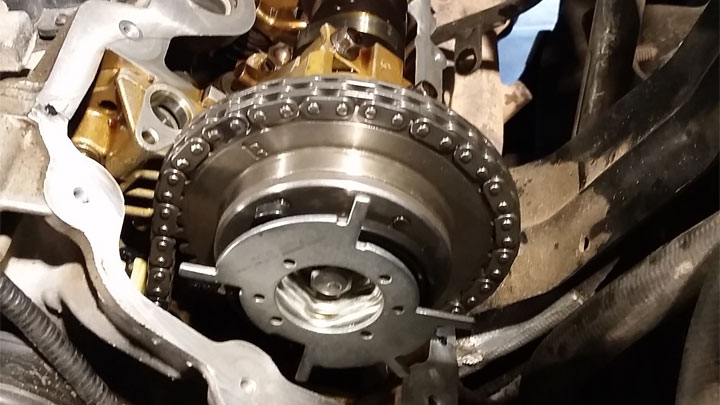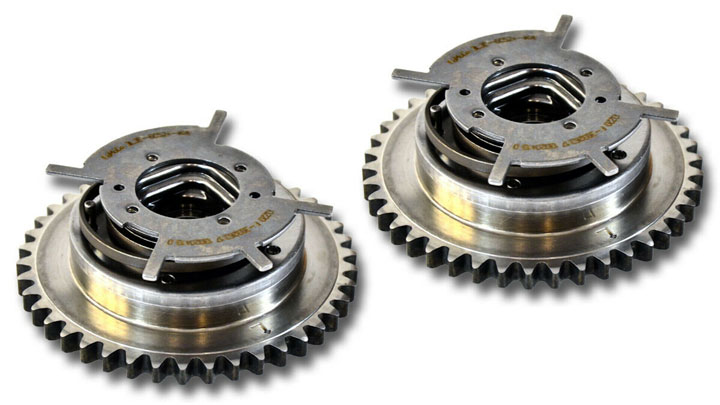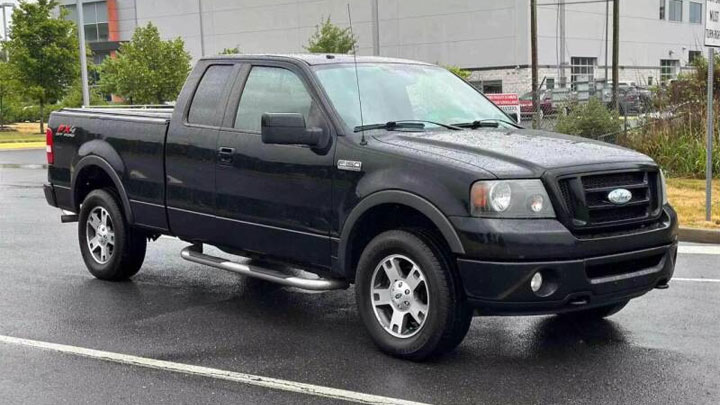5 Symptoms of a Bad Cam Phaser (and Replacement Cost)
Modern engines utilize variable valve timing (VVT) for increased efficiency, adjusting camshaft phasing based on conditions. Though efficient, VVT engines are prone to cam phaser failures, a specific component controlling cam timing.
Understanding the symptoms of cam phaser failure and what causes it arms you with knowledge to address this problem before major engine damage occurs. Unfortunately, cam phaser replacement cost will be high but there’s one thing you can do to lower that.

What Is a Cam Phaser?
A cam phaser is an integral component featured in all engines that utilize variable valve timing. The cam phaser itself is responsible for advancing or retarding the position of an engine’s camshaft(s), in relation to the crankshaft, as commanded by the vehicle’s PCM/ECM.
This effectively varies the timing of each valve-lift event, as compared to that which is standard at static orientation.
Most cam phasers are hydraulically driven, by oil metered to them via a VVT engine’s oil control solenoid(s). These solenoids themselves are electric over hydraulic in nature and are controlled via an electrical signal directed to them by a vehicle’s control module.
Simply put, cam phasing is initiated by a vehicle’s computer, yet carried out by individual cam phasers, with oil control solenoids serving as the intermediary.

When an engine’s operating software determines that a certain degree of cam phasing would prove more efficient under the circumstances at hand, power/ground is directed to an engine’s oil control solenoids, thereby causing them to open, allowing a flow of pressurized oil to their respective cam phasers.
This hydraulic pressure then causes the phasers to index, in turn, mechanically rotating the engine’s camshaft(s).
While all is well, when everything functions as intended, cam phasers do tend to be a high failure item in VVT engines. This places increased importance on recognizing the symptoms of cam phaser failure.
Bad Cam Phaser Symptoms
The failure of a cam phaser is often accompanied by one or more secondary symptoms. By learning to recognize these symptoms, you can minimize excess downtime, and prevent additional engine damage from being done.
The following are several of the most common signs associated with cam phaser failure.
#1 – Illuminated Check Engine Light

An engine’s management software is rather adept at sensing ongoing cam phasing issues, and can quickly pick up on feedback abnormalities from one or more sensors that would indicate a lack of desired cam phasing.
In almost all cases, this will result in the activation of the check engine light.
#2 – Cam Phaser “Click”
More often than not, a failed cam sensor will begin emitting an audible clicking noise, unlike anything that most motorists have heard. This noise is caused when cam phasers are unable to lock in the desired position as they otherwise should, causing a certain degree of float.
#3 – Reduced Engine Performance
When a cam phaser fails, you might also notice that your vehicle’s performance begins to suffer. This lack of operating efficiency comes courtesy of an engine’s inability to actuate its camshafts as desired.
As a result, engine performance suffers as a whole, especially under certain operating criteria.
#4 – Reduced Fuel Economy

You might also notice that your vehicle’s fuel economy suffers, in the presence of a faulty camshaft phaser. This, again, stems from an engine’s inability to actuate its cams as it is otherwise commanded to do by the vehicle’s operating software.
In turn, this leads to reduced combustion efficiency and less than optimal fuel use.
#5 – Rough or Erratic Idle
It’s also possible for a vehicle’s engine to exhibit a rough or erratic idle, if one or both of its cam phasers have failed. This is yet another product of less than optimal performance caused by incorrect or inadequate camshaft indexing or phasing.
One might find that this issue is more evident at certain operating temperatures.
What Causes Cam Phasers to Fail?

As stated above, cam phasers tend to be a high failure rate item in VVT engines. But, why is this?
One of the most common causes of premature cam phaser failure is marginally low engine oil pressure. Cam phasers require adequate oil pressure not only for operation but for lubrication as well. A lack of adequate oil pressure caused by oil degradation or a tired oil pump can quickly damage an engine’s cam phasers.
However, it’s also important to remember that cam phasers can also fail from normal wear and tear. As with any mechanical component, time and continuous use will eventually take their toll. After all, an engine’s cam phasers are actuated multiple times during each driving event, thereby making wear inevitable.
What To Do If You Suspect a Bad Cam Phaser
If you suspect that your vehicle’s cam phaser has failed, you should act swiftly to find a suitable resolution that won’t unnecessarily prolong the repair process. As detailed above, there are a host of secondary symptoms that often accompany the presence of a faulty Camshaft phaser, many of which have negative impacts on a vehicle’s drivability.
While driving a vehicle with a faulty cam phaser is possible, doing so for an extended period of time is not advised, as overall vehicle performance is guaranteed to suffer.
Additionally, the presence of a bad cam phaser is sure to have a negative impact on a vehicle’s achieved fuel economy, thereby causing unnecessary pain at the pump (especially with today’s gas prices). This stems from the fact that a VVT engine is only able to achieve peak efficiency when desired cam phasing is achieved.
In any event, the exact cause of a vehicle’s cam phasing failure should be diagnosed and repaired at the first available opportunity. Doing so will mitigate any additional risk of further engine damage, and will restore an engine’s performance to a heightened state of efficiency.
If you do not feel comfortable tackling such repairs yourself, an appointment should be made with a trusted service center as soon as possible.
Cam Phaser Replacement Cost
Best places to order parts? See: 19 Best Online Auto Parts Stores

The cost associated with cam phaser replacement can vary significantly from one model of vehicle to the next. This is due to variations in both parts and labor between different makes and models. Nonetheless, repairs of this time due tend to fall into a somewhat ballpark price range.
On average, one can expect to pay between $800 and $2,500 to have their engine’s cam phasers replaced. Of this overall price, approximately $100-$400 can be attributed to parts costs, while the remaining $400-$2,000 comes courtesy of the extensive labor hours required to complete such a repair.
You can likely reduce costs by having cam phaser repair completed at a good, independent repair shop as opposed to a dealership, but when there are multiple hours of labor involved, it won’t be cheap.
What Vehicles Are Most Susceptible to Cam Phaser Failure?

While cam phaser failure tends to be relatively common in the bulk of vehicles equipped with VVT engines, some makes and models are more prone to such hardships than others. In fact, several vehicles have even faced recalls of varying degrees for such issues in recent years, further highlighting the severity of cam phaser failure.
Over the last couple of decades, the Ford F-150 has experienced a wide array of cam phaser failures. This issue has been relatively widespread and has spanned several years’ worth of production.
Additionally, a host of related Ford SUVs that share a common powerplant with the F-150, such as the Lincoln Navigator and Ford Expedition have also experienced their share of cam phaser failures.
What Does a Cam Phaser Lockout Kit Do?
A cam phaser lockout kit is a popular modification that can be applied to most VVT engines. Kits of this nature prevent actuation or phasing of an engine’s camshaft from taking place, thereby eliminating variable valve timing capabilities as a whole.
This prevents repeated failure of cam phasers and other VVT-specific components, which tends to be both frustrating and costly. Lockouts are also commonly used by those experiencing cam phaser “rattle”.
However, there are some drawbacks to the use of a cam phaser lockout or elimination kit. Car owners might notice that their vehicle’s performance is partially hampered under certain circumstances, due to a lack of cam phasing ability. One might notice a reduction in fuel economy as well.
- P0480 Code (Symptoms, Causes, and How to Fix) - Apr 19, 2024
- Car Temperature Gauge Stopped Working? (Here’s Why) - Apr 15, 2024
- Ignition Coil vs Coil Pack (What’s the Difference?) - Apr 8, 2024
